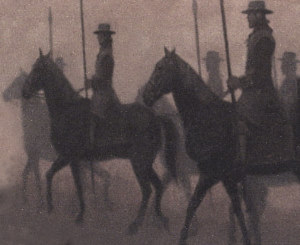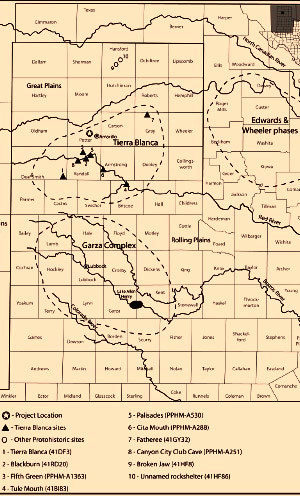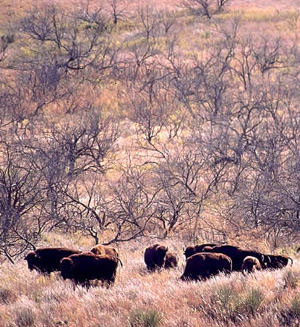What Is the Protohistoric?
The Protohistoric, or contact, period is a relatively short, ca. 200-year, period of considerable change marked by the encroachment of European (Spanish and French) explorers into the region.
The first recorded expedition, that of the explorer Coronado, left Pecos Pueblo in northern New Mexico in 1541 and headed east to find “Quivira” in western Kansas. As they traveled through the Llano Estacado, they encountered vast herds of buffalo and two different groups of Plains Indians. Their exact route through the region is debated, however, and archeologists are still trying to piece together their route. Although documents associated with this expedition are rich with accounts of Native Americans living on the High Plains, they did not record the existence of any settled groups in the abandoned villages along the Canadian River (attributed to peoples connected to the Antelope Creek native culture). Recent discoveries of a campsite attributed to Coronado in lower Blanco Canyon near Lubbock casts doubt that his expedition passed within 80 km (50 mi.) of the Landis property.
Another Spanish expedition, the De Soto Moscoso expedition, entered the eastern part of the Southern Plains of Texas from the east in A.D. 1542. It is believed this expedition may have reached as far west as Fisher County, some 280 to 300 km to the southeast of the present project area, before heading back east. Unfortunately, there are almost no first hand accounts available concerning the native populations of the Texas panhandle from A.D. 1543 to 1750. As Spanish exploration and later colonization of the upper Rio Grande valley (northern New Mexico) pushed northward from New Spain (now Mexico), there were ripple affects across surrounding areas. With the introduction of the horse, various Native groups became mounted raiders, such as the Apaches who, in the early A.D. 1600s, began to harass the sedentary Pueblo groups of present day New Mexico.
Two Southern Plains groups, the Querechos and the Teyas, are described in the chronicles of the Coronado expedition of A.D. 1541. Both groups are described as seminomadic bison hunters who lived in tipis and used dogs for transport. The Teyas were said to be painted or tattooed, whereas the Querechos were not. The chronicles also indicate that the two groups were enemies. Although there is disagreement over Coronado’s route, the probable homeland of the Querechos was in the northern Texas panhandle, in an area extending “from the Canadian River Breaks on the north through the upper drainages of the Red River to the southeast”. The Teya rancherias were first encountered after about five days of travel to the south or southeast, indicating that their homeland was probably among the canyons of the upper Brazos drainage east of present day Lubbock. The archeological Tierra Blanca complex is equated with the Querechos; and the Garza complex, with the Teyas. Researchers argue that the Querechos were almost certainly Plains Apaches, whereas the Teyas were most likely Caddoan speakers.
Following the Coronado expedition, other explorers, Spanish expeditions, and colonists penetrated northward into what is presently northern New Mexico. In 340 B.P. (A.D. 1610) Spanish expeditions began moving caravans up the Rio Grande valley along the Camino Real, which connected central and northern Mexican settlements with the new Spanish capital at Santa Fe. These caravans brought wagonloads of goods and supplies, as well as livestock. The Spanish came to know the more nomadic Plains Indians through various encounters at the Pueblos and learned they resided to the west where the buffalo roam. By the A.D. 1620s the Spanish were well acquainted with the Apaches of northern New Mexico.
During this same general period from roughly A.D. 1690 to 1721, Spanish entradas penetrated into central and eastern Texas and began to establish missions. Mission San Francisco de los Tejas was one of the first missions in eastern Texas, established in 260 B.P. (A.D. 1690). Other missions were established, but no closer than Abilene, greater than 350 km to the southeast of the Landis Property.
During the 17th and 18th centuries the Spanish, mostly from the south and west, and French from the east conducted other expeditions onto the Southern Plains, including trips by Juan de Oñate, Harpe (A.D. 1719), Pierre Mallet (A.D. 1739), Jose Mares (A.D. 1787-88) and Pedro Vial (A.D. 1786, 1788, 1792-3). Of these, it is possible that Oñate and Mallet passed through or near Potter County, but the others were further from the Landis property area. Mallet’s group did record an Indian village in northern Potter County. The precise routes of these various travelers are uncertain. Their regional descriptions provide only general information about the peoples in the region.
The cultural changes that occurred as Europeans spread their influence into the native populations were quite gradual at first, but Europeans goods (guns, glass, metal, and horses) increased in quantities as time passed. It has been stated that the rapidity of economic and technological changes during the period between 400 to 150 B.P. (A.D. 1550 and 1800) has presented keen problems for interpreting the “traditions” of Native groups via the archeological record during this period. It is especially difficult to convincingly assign particular cultural assemblages of this age to specific Native groups, even though this is a problem that has received considerable archeological and ethnohistorical attention.
At least two Protohistoric and apparently different ethnic groups are currently identified for the Texas Panhandle region. The two identified archeological complexes, the Tierra Blanca and the Garza, have been tentatively linked to bands of the historic Apachean and possibly the Wichita (Caddoan) groups, respectively. These two archeological complexes have not been thoroughly defined and their relationship to each other is yet to be clarified. Some of what has been learned about the Protohistoric period across the Southern Plains has been presented in various publications.
The Tierra Blanca complex is defined for a region just south of Amarillo along the headwaters of the Red River in Randall County. This archeological complex reflects a major settlement shift southward from the preceding Antelope Creek phase that apparently had a core area in the Lake Meredith area. A second and better defined archeological complex, the Garza complex, is identified even farther south from the Tierra Blanca complex and appears to be concentrated along the headwaters of the Brazos River system near Lubbock, Texas. The Garza complex dates to 295 to 540 B.P. (A.D. 1410 to 1655), roughly the same time as the Tierra Blanca complex and the Protohistoric Wheeler phase (200 to 550 B.P. or A.D. 1400 to 1750) farther east in Oklahoma. |

Spanish expedition. Although several expeditions traversed the region beginning in the 1500s, there is no evidence at present suggesting they passed close to the site area.  |
| The rapidity of economic and technological changes during the period between A.D. 1550 and 1800 has presented keen problems for interpreting the “traditions” of Native groups via the archeological record during this period. |

Locations of selected protohistoric sites in the Panhandle.
Enlarge to see key.  |

Bison in the Texas Panhandle. The region was part of the range of the huge southern herd, a commodity that eventually was fiercely fought over by Indians and Anglo hunters in the mid-to late nineteenth century. Image courtesy Texas Parks and Wildlife Department.  |
|